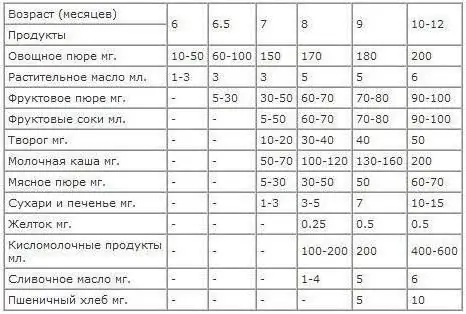2026 Author: Priscilla Miln | [email protected]. Last modified: 2025-01-22 17:55:26
"When and how to start breastfeeding complementary foods?" - this question begins to interest the parents of already a little grown-up babies.

After all, the wrong, as well as too early or late introduction of new products can lead to certain consequences. This article will outline at what age and how to supplement breastfeeding, what are the main misconceptions, as well as useful tips and tricks.
Main feeding mistakes
Many of them came to us from Soviet times. This is explained by the fact that the country was in a difficult post-war situation, and there was an acute shortage of labor. Therefore, most of the recommendations were reduced to the rapid disappearance of milk, as well as accustoming the child to "adult" food. This made it possible for the mother to return to work more quickly. When feeding breastfed babies, the following mistakes should not be made:

- Early introduction of complementary foods. Many grandmothers strive to give water to the baby almost from birth, and it is advised to give drops of fruit juice from a few weeks. However, because of this, diathesis appears in children, digestion is disturbed, and gastric disorders occur. In addition, the juice contains an excessive number of calories for the baby, which can lead to obesity in the future.
- Liquid semolina porridge as the first complementary foods for breastfed babies. Danish scientists have established that it is "the path to death." Studies have been conducted in which it was found that children who consumed semolina in significant quantities grew up weak, prone to colds, diarrhea, rickets and skin rashes.
Complementary feeding for breastfed babies
Mom's milk contains all the necessary vitamins, trace elements, calories, proteins, carbohydrates and fats in the right amount for the full growth and development of the baby. It has been established that a he althy infant is ready to introduce new foods into his diet by about six months. There is also a specific scheme for introducing complementary foods, which will be given in the table below.
Criteria for the readiness of the baby to introduce new food into the diet

For a breastfed baby, it is determined by the following criteria:
- he is over six months old;
- baby weighs 2 or 2.5 times more than at birth;
- baby can sit;
- interested in the food adults eat, tries to eat himself, imitating them, and feed others;
- can and wants to eat from a spoon;
- baby does not spit out food;
- he is not getting enough breast milk, the baby is not full;
- the first teeth appeared (if it did not happen too early).
Baby feeding chart
Food Names |
VI months | VII months | VIII months |
IX months |
X months |
XI-XII mmonths |
| Porridges (oatmeal, buckwheat, rice, etc.), g. | no more than 150 | 150 | 180 | 190 | 200 | 200 |
| Vegetable puree, g. | no more than 150 | 160 | 170 | 190 | 200 | 200 |
| Fruit puree, g. | within 60 | 70 | 80 | 100 | 100 | 100 |
| Butter, g. | 0, 5 | 0, 5 | 0, 5 | 0, 5 | 0, 5 | 0, 5 |
| Vegetable oil, g. | no more than 0, 5 | 0, 5 | within 1 | 1 | 1 | 1 |
| Cottage cheese and products from it, g. | 5 to 40 | 40 | 60 | 60 | 60 | |
| Meat puree, g. | 10 to 40 | 50 | 70 | 70 | 70 | |
| Chicken yolk, piece | quarter | half | half | half | half | |
| Baubels, crackers, g. | within 10 | within 15 | no more than 20 | 20 | 20 | |
|
Fruit juice, ml. |
no more than 60 | 70 | 80 | within 100 | 100 | |
| Fish puree, g. | 5 to 30 | 30 to 60 | 60 | 60 | ||
| Fermented milk products, ml. | from 100 to 150 | 200 | within 200 | 200 | ||
| Bread, g. | 5 | 10 | 10 | 10 | ||
| Daily food intake, g. | 1000 | 1000 | 1000 | from 1000 to 1200 | 1200 | 1200 |
Recommended:
Complementary feeding at 6 months with artificial feeding: rules, scheme, features

When the baby begins to grow up, the question arises about the introduction of complementary foods. This is especially true for those babies who are bottle-fed. After all, such nutrition is similar in composition to breast milk, but it is not capable of completely replacing it. And the baby needs to diversify the menu to provide the body with nutrients
Baby refuses complementary foods: basic rules for the introduction of complementary foods, first products, tips and tricks

Until one year of age, breast milk is the main source of nutrition. It is quite possible that at first the child will not perceive ordinary food and will refuse it in every possible way. Mom should learn about the basic rules for the introduction of complementary foods. And most importantly - to study the psychological aspects of the first complementary foods
Constipation in the baby. Komarovsky E.O. about constipation in infants during breastfeeding, artificial feeding and with the introduction of complementary foods

Such a problem as constipation occurs frequently in infants. Not all parents know how to behave in this case. The famous children's doctor E. O Komarovsky recommends young mothers not to worry, but to carefully monitor the condition of the child
WHO Complementary Feeding Scheme. Complementary foods: table by month. Children food

Children's body requires extremely careful observation in the first years of life. A huge role for the baby at this time is played by complementary foods. Every mother should know how to properly enrich the diet of her child so as not to harm him. Further attention will be offered to the complementary feeding scheme according to WHO
Complementary feeding of formula-fed children: basic rules

Pediatricians recommend artificial babies introduce additional nutrition a little earlier than breastfed babies. Five to six months is the optimal age to start breastfeeding babies. Where to start, what are the basic rules for the introduction of complementary foods?

